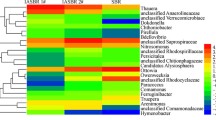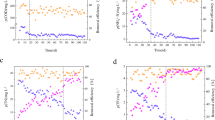Abstract
This work reports a comparison study between an intelligent aeration-controlled Anoxic/Oxic system and a conventional continuing aeration Anoxic/Oxic system for the removal of major containment, which includes the performance of major containments treatment, microbial kinetics and microbial communities by high-throughput sequencing tool. The results showed that at the end of low dissolved oxygen start-up period, there was few differences on the performance between the intelligent aeration-controlled Anoxic/Oxic system, with a 60% aeration saving, and conventional continuing aeration Anoxic/Oxic system. Moreover, the differences of activated sludge microbial community were significant. The kinetics study shows that the microbial kinetics for the intelligent aeration-controlled Anoxic/Oxic system was faster than for the comparison system, especially the yield coefficient for autotrophic biomass was much higher. The high-throughput sequencing tool also have provided a reasonable comparison of microbial community in aeration tank and indicated that the low dissolved oxygen demand species were more abundant. Meanwhile, the functional relative abundance had little statistical differences. However, the more abundance of low dissolved oxygen demand species gradually represented function of the less abundance species in the end of the start-up process. This study can provide a helpful information in the intelligent aeration-controlled Anoxic/Oxic system optimization to further removal the specific contaminates in the domestic wastewater treatment.





Similar content being viewed by others
References
APHA (2012) Standard methods analysis water and wastewater. APHA, Washington
Balakrishnan A, Kanchinadham SBK, Kalyanaraman C (2018) Evaluation and kinetic study on enzyme supplementation to biological treatment of vegetable tanning process wastewater. Int J Environ Sci Technol 16:5945–5954
Caporaso JG, Lauber CL, Walters WA, Berglyons D, Huntley J, Fierer N, Owens SM, Betley J, Fraser L, Bauer M (2012) Ultra-high-throughput microbial community analysis on the Illumina HiSeq and MiSeq platforms. ISME J Multidiscip J Microb Ecol 6:1621–1624
Chakraborty A, Picardal F (2013) Induction of nitrate-dependent Fe(II) oxidation by Fe(II) in Dechloromonas sp. strain UWNR4 and Acidovorax sp. strain 2AN. Appl Environ Microbiol 79:748–752
Drouin R, Gao S, Holmquist GP (1996) Agarose gel electrophoresis for DNA damage analysis. Springer, New York
Geyik AG, Kılıç B, Çeçen F (2016) Extracellular polymeric substances (EPS) and surface properties of activated sludges: effect of organic carbon sources. Environ Sci Pollut Res 23:1653–1663
Guo J, Peng Y, Wang S, Yang X, Wang Z, Zhu A (2012) Stable limited filamentous bulking through keeping the competition between floc-formers and filaments in balance. Biores Technol 103:7–15
Hao L, Liss SN, Liao BQ (2016) Influence of COD:N ratio on sludge properties and their role in membrane fouling of a submerged membrane bioreactor. Water Res 89:132–141
Kapagiannidis AG, Zafiriadis I, Aivasidis A (2009) Comparison between UCT type and DPAO biomass phosphorus removal efficiency under aerobic and anoxic conditions. Water Sci Technol 60:2695–2703
Kruger NJ (2002) The Bradford method for protein quantitation. Humana Press, New Jersey
Krustok I, Truu J, Odlare M, Truu M, Ligi T, Tiirik K, Nehrenheim E (2015) Effect of lake water on algal biomass and microbial community structure in municipal wastewater-based lab-scale photobioreactors. Appl Microbiol Biotechnol 99:6537–6549
Larsen P, Nielsen JL, Otzen D, Nielsen PH (2008) Amyloid-like adhesins produced by floc-forming and filamentous bacteria in activated sludge. Appl Environ Microbiol 74:1517–1526
Leyva-Díaz JC, Calderón K, Rodríguez FA, González-López J, Hontoria E, Poyatos JM (2013) Comparative kinetic study between moving bed biofilm reactor-membrane bioreactor and membrane bioreactor systems and their influence on organic matter and nutrients removal. Biochem Eng J 77:28–40
Li Y, Niu W, Wang J, Liu L, Zhang M, Xu J (2016) Effects of artificial soil aeration volume and frequency on soil enzyme activity and microbial abundance when cultivating greenhouse tomato. Soil Sci Soc Am J 80:1208–1221
Ma B, Wang S, Cao S, Miao Y, Jia F, Du R, Peng Y (2016) Biological nitrogen removal from sewage via anammox: recent advances. Biores Technol 200:981–990
Monod J (1949) The growth of bacterial cultures. Annu Rev Microbiol 3:371–394
Narayanasamy S, Muller EEL, Sheik AR, Wilmes P (2015) Integrated omics for the identification of key functionalities in biological wastewater treatment microbial communities
Nielsen SS (2017) Total carbohydrate by phenol-sulfuric acid method. Springer, Berlin
Piao Z, Xinbing C, Xiujin Z, Yanping L, Yijun K, Chengda H, Shixue Y (2011) Effect of aeration strength on nitrous oxide emission during simultaneous nitrification and denitrification. Chin J Environ Eng 5:2658–2662
PireSierra MC, CegarraBadell DD, CarrasqueroFerrer SJ, AnguloCubillan NE, DíazMontiel AR (2016) Nitrogen and COD removal from tannery wastewater using biological and physicochemical treatments. Revista Facultad De Ingeniería 80:63–73
Ramalho RS, Ramalho RS, Beltrán DJ, Lora FD (1991) Tratamiento de aguas residuales. Editorial Reverté, S.A., Barcelona
Rédei GP (2008) Cetyl trimethylammonium bromide (CTAB). Springer, Netherlands
Regmi P, Miller MW, Holgate B, Bunce R, Park H, Chandran K, Wett B, Murthy S, Bott CB (2014) Control of aeration, aerobic SRT and COD input for mainstream nitritation/denitritation. Water Res 57:162–171
Rieger L, Jones RM, Dold PL, Bott CB (2014) Ammonia-based feedforward and feedback aeration control in activated sludge processes. Water Environ Res 86:63–73
Rodriguez FA, Poyatos JM, Reboleiro-Rivas P, Osorio F, Gonzalez-Lopez J, Hontoria E (2011) Kinetic study and oxygen transfer efficiency evaluation using respirometric methods in a submerged membrane bioreactor using pure oxygen to supply the aerobic conditions. Biores Technol 176:6013–6018
Rodríguez-Sánchez A, Leyva-Díaz JC, Poyatos JM, González-López J (2017) Performance and kinetics of membrane and hybrid moving bed biofilm-membrane bioreactors treating salinity wastewater. AIChE J 63:3329–3342
Shen TG, Yong Q, Shi HC (2010) Mathematical simulation of feedforward control for nutrient removal in anaerobic–anoxic–oxic processes. J Environ Eng Sci 27:633–641
Spanjers H, Vanrolleghem P, Olsson G, Doldt P (1998) Respirometry in control of the activated sludge process. Water Sci Technol 34:117–126
Thunberg A (2009) Energy optimization of the aeration process at Käppala wastewater treatment plant in Stockholm. Uppsala University, Sweden
Turkmenler H (2019) Investigation of energy efficiency in Gebze Wastewater Treatment Plant. Int J Environ Sci Technol 16:6557–6564
Wang AM, Doyle MV, Mark DF (1991) Quantitation of mRNA by the polymerase chain reaction. Springer, Berlin
Wu H, Fan J, Zhang J, Ngo HH, Guo W, Hu Z, Liang S (2015) Decentralized domestic wastewater treatment using intermittently aerated vertical flow constructed wetlands: impact of influent strengths. Biores Technol 176:163–168
Xin X, He J, Wang Y, Feng J, Qiu W (2016) Role of aeration intensity on performance and microbial community profiles in a sequencing batch reaction kettle (SBRK) for wastewater nutrients rapid removal. Biores Technol 201:140–147
Xu C, Zhang W, Dai J, Wang W, Tian Y, Xuedong HU, Takasi S (2014) Application of AOSD intelligent aeration technology to the small wastewater treatment plant. Chin Environ Sci Technol 37:152–156
Xu M, Zhanbo H, Yaqi Q, Hongzhen L, Phoungern I, Suemura T (2017) Treatment efficiency and nitrogen removal mechanism in low C/N ratio domestic wastewater treatment by intelligent aeration controlled A/O process. Chin J Environ Eng 10:5359–5367
Yang O, Zhanbo H, Cui W, Huilin W, Minyang X, Suemura T (2016) Domestic wastewater treatment by A/O process with an intelligent aeration control system. Chin J Environ Eng 10:6255–6260
Yasir M, Chung EJ, Song GC, Bibi F, Jeon CO, Chung YR (2011) Chitinophaga eiseniae sp. nov., isolated from vermicompost. Int J Syst Evol Microbiol 61:2373–2378
Zeirani T, Fallah N, Nasernejad B (2019) Biological treatment of real petrochemical wastewater containing styrene using submerged membrane bioreactor: effects of HRT. Int J Environ Sci Technol 16:3793–3800
Acknowledgements
The authors gratefully thank researcher Yuhei Inamori and researcher Takashi Suemura from Foundation for Advancement of International Science (FAIS) for providing AOSD system start-up operation guidance. This work was supported by the Research and Development Program of Guangxi, China (Grant No. AB19110001) and the Science and Technology Base and Talent Project of Guangxi, China (Grant No. AD17195092).
Author information
Authors and Affiliations
Corresponding author
Additional information
Editorial responsibility: J Aravind.
Rights and permissions
About this article
Cite this article
Hu, Z.B., Zheng, Y.K., Xu, M.Y. et al. Comparison of performance, microbial kinetics and microbial community between intelligent and conventional aeration-controlled Anoxic/Oxic systems. Int. J. Environ. Sci. Technol. 17, 2085–2094 (2020). https://doi.org/10.1007/s13762-019-02590-2
Received:
Revised:
Accepted:
Published:
Issue Date:
DOI: https://doi.org/10.1007/s13762-019-02590-2




